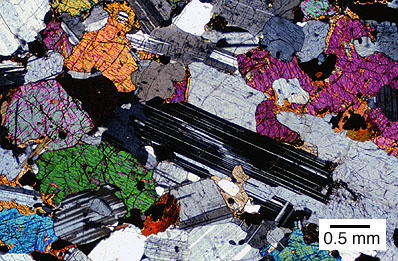(Part three following the basics of metamorphic reactions & contact metamorphism)
Ok, so now we want to make a garnet schist from our mud–I’m assuming this is a garnet-muscovite-biotite paraschist, since that’s what most people envision when they think garnet schist. (I’m actually going to take this one step further and go all the way to a migmatite.) Remember, we’re starting with a water-rich, Si + Al-rich protolith that has some Fe2+, Ca2+, Mg2+, Na+, and K+ as well.
In order to get a schist, we need to have foliated rocks, which are due to a differential pressure. The most common cause of differential pressure is orogenesis or a mountain-building event. An orogeny occurs when plate tectonics cause the collision of 2+ plates. The rocks caught in the middle become squished and heated transforming from shales into a variety of foliated metamorphic rocks. Almost all mountain belts in the world are due to orogenesis and most are composed of a mix of foliated metamorphic rocks, intrusive igneous rocks with associated contact metamorphic aureoles, extrusive igneous rocks, and a mix of sedimentary rocks from non-calm environments.
The mud to shale transformation will be the same, so we’re start with the shale. This time we’re going to force the rock to undergo a differential stress (stress is simply pressure over a specific a specific area) concurrent with increasing the temperature. Because of the differential stress, the existent minerals either rotate or grow parallel to the minimum stress direction.
At relatively low temperatures, the rock will become a slate. Though harder & able to break more easily than shale, slates are still very, very fine grained so that individual grains of are not visible to the naked eye.
As the temperature increases, more water is driven off. Muscovite – KAl2(AlSi3O10)(F,OH)2 & chlorite – (Mg,Fe)3(Si,Al)4O10(OH)2·(Mg,Fe)3(OH)6 (both are micas) are now stable & start to grow large enough to be seen with the naked eye. Quartz & plagioclase (NaAlSi3O8 – CaAl2Si2O8) are also stable, but difficult to see with the naked eye. The new rock is called a phyllite, which will not break along planes that are as smooth as the slate.
Finally, we drive off enough water that we move from the land of phyllites with micas just barely big enough to see to larger grained schists. Chlorite & muscovite are joined by biotite – K(Mg,Fe)3(AlSi3O10)(F,OH)2 and the grains are now larger. The first schists aren’t very different from our phyllites, but once we start to break down chlorite, we start to reach some “exciting” rock – garnet schists. (Garnets have a wide compositional range — the general formula is X3Y2(SiO4)3 where X = Ca2+, Mg2+, Fe2+, Mn2+, Y = Al3+, Fe3+, Cr3+.)

garnet (clear, high relief in center) - muscovite (clear, moderate relief) - biotite (brown) schist from northeastern Vermont in PPL (quartz & plagioclase are the low relief, clear grains)
As we continue to heat the rock, the amount of micas in the rock decreases as we drive off more water & the percent of anhydrous minerals increases. From garnet, we cross into staurolite ((Fe2+,Mg,Zn)1.5-2Al9[O6|(OH,O)2|(SiO4)4]) schist for a short period of time. Though staurolite is hydrous, the amount of water needed for it is much less than the micas.
As staurolite starts to break down, we’ve reached another critical point. Our rocks are going to shift from containing a reasonable amount of micas to being comprised of a high percentage of anhydrous minerals. One result of this shift is that we’re going to move away from schists that are mainly due to the alignment of platy micas and instead form gneisses. A “gneissic” texture simply means that the minerals are banded with darker colored minerals (biotite, amphibole) together & lighter colored minerals (e.g. quartz, plagioclase) separated from each other.
As first muscovite then biotite breaks down, the rock can take two different paths. If the reaction occurs slowly and water just trickles into the system, the gneiss will simply become more & more anhydrous in a solid state until the granitoid-melting temperature is reached.
If the breakdown releases a relatively large amount of water into the system at one time while the rock remains at a high temperature, the rock may start to melt “early.” The first things to melt will be the “light” colored minerals & when they solidify again, they’ll be called “leucosomes.” The material that requires higher temperatures to melt will be the darker minerals and is referred to as “melasomes.” The rock as a whole will be known as a “migmatite.”
(I can’t find a reasonable photomicrograph of a migmatite–I’ll have to look around a bit.)
Let’s do a check on composition. Our current rock is probably quartz + plagioclase + K-feldspar + sillimanite + garnet + amphibole / pyroxene / biotite + oxides. Main components of the rock? Si + Al. Check. Minor components? Fe2+, Ca2+, Na+, K+, Mg2+. Check. Is losing most / all of our water reasonable? Check. Looks like we’ve successfully gone from our protolith to metamorphic rock compositionally. (In reality, I should do a “real” balance–but that’s a bit overboard for here & now.)
Ok, so that’s mud -> migmatite. Boy is this post overly long even after separating it into three posts–if anyone is still there & wants me to go through the metamorphism of a basalt, limestone, some other protolith of your choice, please just leave a comment.
Read Full Post »



















































